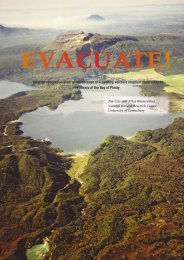Tsunami evacuation: Lessons from the Great East Japan earthquake ...
Tsunami evacuation: Lessons from the Great East Japan earthquake ...
Tsunami evacuation: Lessons from the Great East Japan earthquake ...
You also want an ePaper? Increase the reach of your titles
YUMPU automatically turns print PDFs into web optimized ePapers that Google loves.
2012<br />
2.0 INTERVIEW OUTCOMES<br />
This section discusses emergent <strong>the</strong>mes <strong>from</strong> <strong>the</strong> interviews with disaster prevention and<br />
emergency service officials in <strong>the</strong> Tōhoku region, and relates <strong>the</strong>se issues to Washington<br />
and New Zealand. Each sub-section contains information which has some cross-over to<br />
o<strong>the</strong>r <strong>the</strong>mes, and several <strong>the</strong>mes may be inter-related or influenced by <strong>the</strong> same factors.<br />
No <strong>the</strong>me or event highlighted here should be considered in isolation. A summary of <strong>the</strong> key<br />
points raised in interviews at each location is presented in Appendix 3 for quick reference.<br />
Recommendations for Washington and New Zealand are given separately in Section 3.0 in<br />
consistent sub-sections.<br />
2.1 Community involvement in <strong>evacuation</strong> planning and preparedness<br />
Community disaster groups are common in <strong>Japan</strong> and many cities and towns have multiple<br />
disaster prevention groups who are engaged with local government in awareness and<br />
education activities at <strong>the</strong> neighbourhood level.<br />
High levels of community engagement were apparent in most of <strong>the</strong> interviews, particularly<br />
with residents being involved in production of <strong>evacuation</strong> maps in Kamaishi, Ōfunato,<br />
Kesennuma, and Minami-Sanriku. In <strong>the</strong>se locations, <strong>the</strong> prefectural government provides<br />
hazard mapping to <strong>the</strong> municipal government who <strong>the</strong>n work with community groups to<br />
develop <strong>the</strong> <strong>evacuation</strong> maps and identify suitable (or historical) places of refuge. This<br />
approach is not ubiquitous – in Natori City, <strong>the</strong> development of <strong>evacuation</strong> mapping was said<br />
to be <strong>the</strong> responsibility of local government who <strong>the</strong>n provide <strong>the</strong> finalised <strong>evacuation</strong> map to<br />
<strong>the</strong> public.<br />
The local community was involved in identification of potential buildings for vertical tsunami<br />
<strong>evacuation</strong> in Ōfunato, Kesennuma and Kamaishi. Community members had ei<strong>the</strong>r<br />
approached building owners about <strong>the</strong> potential use of a building, or approached municipal<br />
government with suggestions of potential buildings. There have been mixed outcomes<br />
regarding <strong>the</strong> eventual official designation of buildings where <strong>the</strong> community have been<br />
involved in this process, but it is clear that community engagement in vertical <strong>evacuation</strong><br />
strategies is beneficial, as discussed in Section 2.7.<br />
In addition to <strong>the</strong> nationwide tsunami disaster drill carried out annually on <strong>the</strong> anniversary of<br />
<strong>the</strong> 1960 Chile tsunami, community groups in Natori City, Ishinomaki City and Miyako City<br />
carry out more regular drills for tsunami, as well as o<strong>the</strong>r hazards. The officials we<br />
interviewed were not able to provide data on <strong>the</strong> levels of resident participation in such drills.<br />
Community involvement in planning and preparedness is well-established in Washington,<br />
where <strong>the</strong> Emergency Management Division engages with coastal communities through<br />
county level emergency management groups, who co-ordinate community education<br />
sessions and <strong>evacuation</strong> drills. There has previously been a high level of community interest<br />
in participating in focus groups on tsunami risk and preparedness, with proactive preparation<br />
among many hotels in coastal Washington (Johnston et al., 2005). An AHAB siren test and<br />
<strong>evacuation</strong> drill on September 21st 2011 achieved 100% participation of schools in Grays<br />
Harbor County, although participation was lower in o<strong>the</strong>r counties (J. D. Schelling, personal<br />
communication, December 17th 2011), illustrating <strong>the</strong> high levels of engagement which have<br />
been achieved. Project Safe Haven is a current vertical <strong>evacuation</strong> strategy development<br />
GNS Science Report 2012/17 13

















